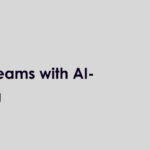AI Solutions for Simplifying the EHCP Process

The integration of generative AI public sector workflows promises to revolutionise local government operations in the UK. As we delve into the potential of this cutting-edge technology, we’ll explore how it can enhance efficiency, reduce costs, and improve public services. This comprehensive guide aims to provide insights into the benefits, applications, and implementation strategies of GenAI for business within the public sector.
Understanding Generative AI in the Public Sector
Generative AI (GenAI) refers to AI systems capable of creating content, making decisions, and solving complex problems autonomously. Unlike traditional AI, which relies on predefined rules and data sets, Gen AI can learn from vast amounts of information and generate innovative solutions.
Key Benefits of Generative AI for Local Governments
- Efficiency and Productivity: By automating routine tasks, GenAI allows government employees to focus on more strategic and value-added activities.
- Cost Reduction: Automating processes reduces operational costs, allowing local governments to allocate resources more effectively.
- Improved Decision-Making: GenAI provides data-driven insights, helping policymakers make informed decisions.
- Enhanced Public Services: From chatbots to predictive maintenance, GenAI improves the quality and responsiveness of public services.
Applications of Generative AI in Local Government
- Automated Customer Service
Local governments can deploy AI-powered chatbots to handle citizen inquiries, reducing the workload on human staff. For example, Enfield Council in London has implemented an AI chatbot named Amelia, which handles a variety of tasks from answering questions to processing requests.
- Predictive Analytics
GenAI can analyse vast amounts of data to predict trends and outcomes. This is particularly useful in areas like social services, where predicting the needs of vulnerable populations can lead to proactive support and intervention.
- Fraud Detection
AI systems can detect unusual patterns and flag potential fraudulent activities, ensuring the integrity of public funds. This is crucial for areas like tax collection and benefits distribution.
- Infrastructure Maintenance
Using sensors and AI, local governments can predict when infrastructure such as roads and bridges need maintenance, preventing costly repairs and enhancing public safety.
- Document Processing
GenAI can automate the processing of large volumes of documents, from permits to applications, significantly speeding up administrative tasks and reducing errors.
Implementing GenAI for Business in Local Government
Implementing GenAI for business within local governments requires a strategic approach:
Step 1: Assess Needs and Objectives
Identify the specific areas where GenAI can provide the most value. This could be customer service, data analysis, or operational efficiency.
Step 2: Develop a Roadmap
Create a detailed implementation plan, including timelines, budgets, and key performance indicators (KPIs). Engage stakeholders from various departments to ensure a holistic approach.
Step 3: Choose the Right Technology
Select AI solutions that align with your needs. It’s crucial to choose technology that is scalable and can integrate with existing systems.
Step 4: Train Staff
Ensure that employees are trained to work alongside AI. This includes understanding how to interpret AI insights and manage AI systems.
Step 5: Monitor and Optimise
Continuously monitor the performance of AI systems and make adjustments as needed. Use KPIs to measure success and identify areas for improvement.
Challenges and Considerations
While the benefits of GenAI for business in local government are clear, there are several challenges to consider:
- Data Privacy and Security: Ensuring the protection of sensitive data is paramount.
- Ethical Concerns: AI systems must be designed to avoid biases and ensure fair treatment of all citizens.
- Integration with Legacy Systems: Many local governments use outdated systems that may be difficult to integrate with new AI technologies.
- Cost and Resources: Initial implementation can be costly, and there is a need for skilled personnel to manage AI systems.
The Future of Generative AI in Local Government
The future of AI in local government is promising, with continuous advancements in AI technology offering even more sophisticated tools for public sector use. As AI becomes more integrated into government operations, we can expect:
- Increased Automation: More tasks will be automated, allowing employees to focus on strategic initiatives.
- Advanced Predictive Capabilities: Improved data analysis will enable governments to anticipate and respond to issues more effectively.
- Personalized Public Services: AI can provide tailored services to citizens based on their unique needs and circumstances.
- Enhanced Collaboration: AI will facilitate better communication and collaboration across departments and agencies.
Conclusion: Embrace the Future with Agilisys Transform
Local governments have a unique opportunity to leverage generative AI public sector technologies to enhance their operations and provide better services to their citizens. As the examples and case studies show, the implementation of GenAI for business can lead to significant improvements in efficiency, cost savings, and service quality.
At Agilisys Transform, we specialise in helping local governments harness the power of AI in local government. Our comprehensive GenAI services, including QuickAction, are designed to streamline workflows, improve decision-making, and deliver exceptional public services.
Ready to transform your public sector workflows with GenAI? Contact Agilisys Transform today and discover how we can help you achieve your goals. Let’s connect and make a difference together.


